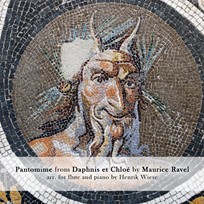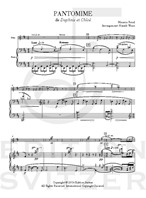
Pantomime - Daphnis et Chloé
Composer: Maurice Ravel
Instrument: Flute and Piano
Level: Advanced
Published: 2014
Price: €19.00
Item details
-
Description +
-
Arranged by Henrik Wiese
Duration: 5 min.
The ballet Daphnis et Chloé by Maurice Ravel (1875–1937) exists in two original instrumentations, one for piano alone (1910), the other for large orchestra with choir (1912). From the ballet Ravel extracted the two suites for orchestra (1911-1931), of which the second one with well-known flute solo enjoys great popularity. Moreover, in Paris in 1912 Durand published a collection of three Fragments symphoniques from the ballet for piano alone. On the contrary to the suites for orchestra, where the single portions smoothly merge, these three fragments are not joined up and stand side by side. The third fragment is entitled as Scène de Daphnis et Chloé and contains the great flute solo.
The original version for piano has served as a basis for the present arrangement. Ravel's demanding, but nevertheless very pianistic writing was simplified in some places by extracting a flute part from it. The difficult question, where to start and end such an arrangement, was luckily answered in the fragment by the composer himself.
-
-
Instrumentation +
-
Flute and Piano
-
-
About the composer +
-
Joseph Maurice Ravel (7 March 1875 – 28 December 1937) was a French composer, pianist and conductor. He is often associated with impressionism along with his elder contemporary Claude Debussy, although both composers rejected the term. In the 1920s and '30s Ravel was internationally regarded as France's greatest living composer.
Born to a music-loving family, Ravel attended France's premier music college, the Paris Conservatoire; he was not well regarded by its conservative establishment, whose biased treatment of him caused a scandal. After leaving the conservatoire Ravel found his own way as a composer, developing a style of great clarity, incorporating elements of baroque, neoclassicism and, in his later works, jazz. He liked to experiment with musical form, as in his best-known work, Boléro (1928), in which repetition takes the place of development. He made some orchestral arrangements of other composers' music, of which his 1922 version of Mussorgsky's Pictures at an Exhibition is the best known.
As a slow and painstaking worker, Ravel composed fewer pieces than many of his contemporaries. Among his works to enter the repertoire are pieces for piano, chamber music, two piano concertos, ballet music, two operas, and eight song cycles; he wrote no symphonies or religious works. Many of his works exist in two versions: a first, piano score and a later orchestration. Some of his piano music, such as Gaspard de la nuit (1908), is exceptionally difficult to play, and his complex orchestral works such as Daphnis et Chloé (1912) require skilful balance in performance.
Ravel was among the first composers to recognise the potential of recording to bring their music to a wider public. From the 1920s, despite limited technique as a pianist or conductor, he took part in recordings of several of his works; others were made under his supervision.
-
-
Credits +
-
Front Cover design: Ronni Kot Wenzell
Engraving: Ary Golomb
Printed in Copenhagen, Denmark
www.editionsvitzer.com
-




